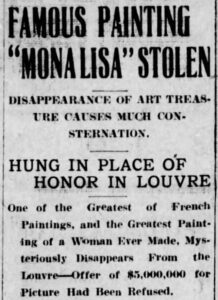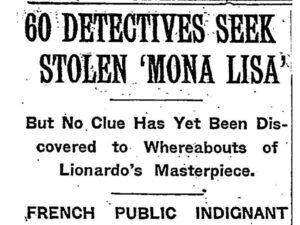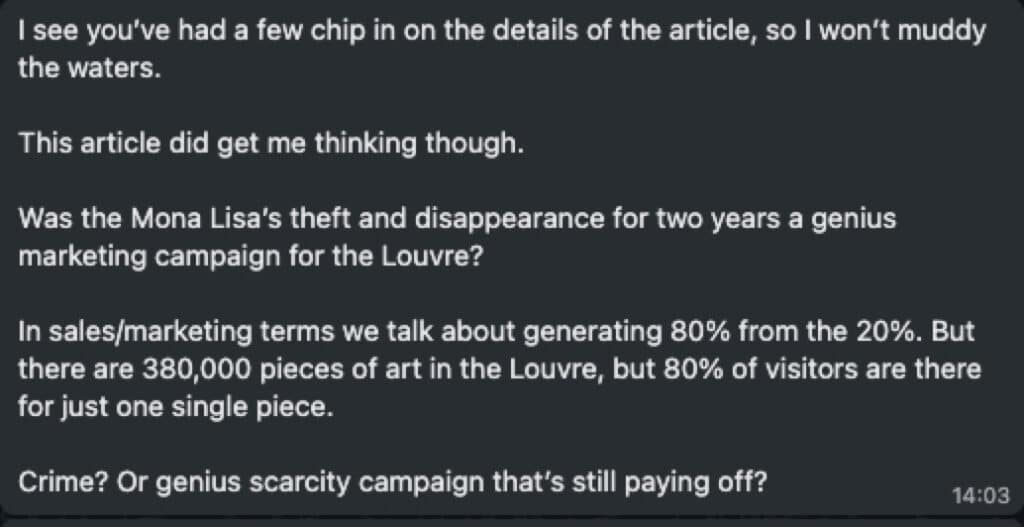How did the Mona Lisa become and stay so famous?
Table of Contents
Is the Mona Lisa much better than other paintings? It’s ‘very good’ – but the best painting in the world? Well, in 2020 it was named as the most disappointing tourist attraction in the world by Britons.
The Mona Lisa is, yet, more famous than any other painting in the world. In 2018, 10 million people headed to the Louvre. 80% of them there for the Mona Lisa.
So, if it’s only ‘very good’, yet attracts visitors and a lot of money every year – how did it get to this place? For me… it’s all about good marketing.
Today – I’m going to take a look back in time to investigate ‘how did the Mona Lisa become and stay so famous?’. I’ll be doing this from a storytelling, PR, and tactics perspective. Ultimately, I’m interested to see if there are any answers we can use in our own work.
Source: https://www.nytimes.com/2019/11/06/arts/design/mona-lisa-louvre-overcrowding.html
The Great Story of the Mona Lisa – How she became a celebrity
The Mona Lisa was painted around 1503 by Leonardo da Vinci – making it around 518 years old. The painting has hung on the walls of the palaces of Louis XIV and Napoleon, before settling at the Louvre in 1797.
In 1873 Walter Pater wrote ‘Renaissance’. This was a time where people weren’t travelling much, so this did much to elevate the Mona Lisa’s public standing. Pater’s extravagant words of “She is older than the rocks among which she sits; like the vampire, she has been dead many times.” painted a picture in the minds of the art world and laid a foundation (and many quotes!) for what was to come.
Yet – the painting still only remained ‘art world’ famous.
But it was when the Mona Lisa turned 408 years, things started happening for her. In August 1911, the famous painting was stolen by Vincenzo Perugia and two others ‘as an act of patriotic vengeance for Napoleon’s depredations in Italy’.
Two years later, the artwork returned to the Louvre. But, hanging on the hook was no longer about the painting – it was a hanging story, created in its absence.
For marketers: The empty hooks had allowed people to create their own stories around the myth of the Mona Lisa. This was in a time where most people discussing the picture would never have seen the painting. Here, we see a value beyond the product- a change in the perception of it. As Rory Sutherland says – ‘perspective is everything’.
“If a different one of Leonardo’s works had been stolen, then that would have been the most famous work in the world — not the Mona Lisa,” said Noah Charney, professor of art history and author of “The Thefts of the Mona Lisa.” (Link to full article)
This speaks to investing in branding, storytelling and advertising. All be it accidentally, the Mona Lisa is one of the greatest marketing stories of all time. It all started with a great story about a very good product.
Viewing the story from a PR perspective
The press used the opportunity to run what amounted to a two-year marketing campaign on behalf of the painting.
Regular articles in international papers reinforced the myth with headlines including words such as the ‘Finest picture in the world’.
Source: https://blog.newspapers.com/the-missing-mona-lisa/
Given the time – newspaper inches were one of the key marketing channels. It was through this channel that the public became aware of the painting, even without seeing it.
Source: New York Times – A New York Times headline from August 24, 1911, reported the investigation into the disappearance of the “Mona Lisa.”
The painting entered public consciousness. A joke at the time was ‘I’m popping out to The Louvre, do you want me to pick up anything?’. Showing a new, broader cultural relevance to the painting.
So, what does this mean for marketers? It’s all about tactical selection, and also the power of the press (Carrie Rose recently gave a great talk on how to get Press Coverage and Links). Granted, there wasn’t much of a choice here, but if the press hadn’t picked up on the story, then the Mona Lisa wouldn’t have found the fame it has.
This speaks to distribution: something often neglected after the point of content creation. The story ticked the boxes of being the kind of content people would talk about at the pub and evoking emotion. It was, therefore, more likely to be picked up.
The final element here is that The Louvre couldn’t control the narrative – as seen by the jokes at their expense. This was important because it allowed a mythology to become world-famous. The same applies to marketers, particularly in the social media world. Embrace the chaos – don’t always look to control everything.
How the marketing channels changed
While the reception at the time was impressive – 110 years on, the Mona Lisa is still the world’s most famous painting. Why?
PR and Word of mouth worked the painting into wider culture. But, over time, the channels/tactics changed to continue bringing further success.
For example, in 1919, Marcel Duchamp produced ‘L.H.O.O.Q’ – placing a moustache on a copy of the famous painting. Salvador Dali created his own self-portrait in the image of the Mona Lisa, too.
Marketers, what can we learn? Mark Ritson speaks about share of voice (or its modern equivalent, the share of search). And it’s fair to say that the Mona Lisa benefited from a period of excess share of voice in PR channels.
Yet, as the story dropped out of newspapers, the Mona Lisa benefitted from a new set of channels across the cultural spectrum.
This speaks to two truths:
- Marketing channels change over time.
- Momentum matters.
Marketing channels change over time. – While it wasn’t a conscious choice on the part of the Louvre, the coverage of the Mona Lisa changed from press to wider cultural channels. (You know it’s true when The Simpsons start riffing on you, as below). As marketers, we need to be aware the tactical execution of our campaigns will change over time, even if the fundamentals stay true.
Momentum – This is a truth Dave Gerhardt speaks of regularly, but also one we’ve experienced at The Marketing Meetup. Marketing is about momentum. The Mona Lisa is a snowball rolling downhill. And while it may be an accidental marketing success – a success it is by any metric.
So, why did the Mona Lisa become so famous, what can we learn?
So, what can marketers learn from the success of the Mona Lisa? For me, there are three main themes.
- Tell a story. Success relies on a great product AND great marketing – it’s not just one or the other.
- Always focus on distribution as much as content creation.
- And, on the point of distribution – allow your channels and tactics to flex over time. What works today won’t necessarily tomorrow.
The Mona Lisa’s continued success is a fine example of marketing having the power to create long-lasting impressions that almost defy objective logic. As marketers, we can use these lessons in our day to day roles.
Some questions we can ask ourselves are:
- Where is the story here? Rather than saying ‘this is what it is’ – can we tell ‘how this got here’, or ‘this is how the product will be used in the real world’
- Rather than content having a starting and ending point at the point of publishing, consider how the content will live, breathe, and find more people after the point of publishing
- And realise that while the strategy and the messaging often stay the same, the tactics and channels you will use will change over time. Curiosity is one of those things that we inescapably need as marketers. Listen, read, watch and keep your eyes out for any tactical advantage – no matter the level you operate at.
And, if you can’t get on board with all the above… then our resident branding expert, Baz Richardson, has a conspiracy theory for you…




